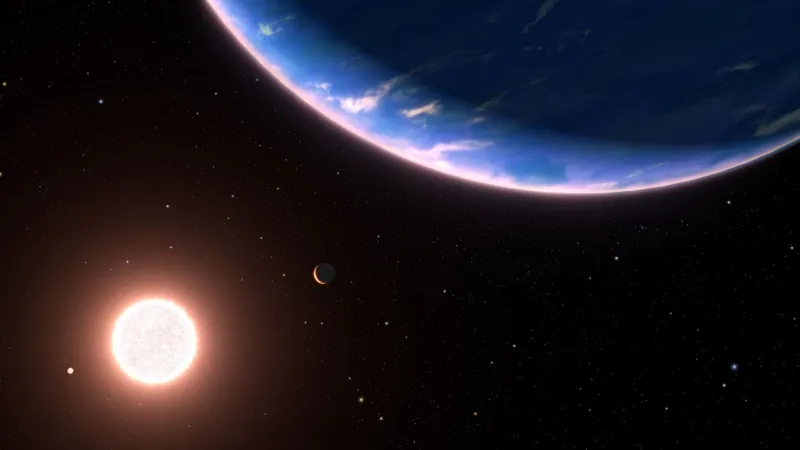
The Exciting Discovery of GJ 9827 d: A Water Vapor-Saturated Steam World
2024-10-31
Author: Daniel
Introduction
In a groundbreaking revelation, the James Webb Space Telescope (JWST) has detected an exoplanet that is unlike any previously observed: GJ 9827 d. This unique celestial body boasts an atmosphere almost entirely made up of water vapor, offering astronomers their first observational proof of what they have long theorized about such planets.
About GJ 9827 d
Located approximately 100 light-years away, GJ 9827 d is a sub-Neptune class exoplanet—twice the size of Earth and three times its mass—orbiting a K-type star. Initially discovered by the Kepler Space Telescope during its K2 mission, GJ 9827 d had previously been studied by the Hubble Space Telescope in 2023, which hinted at the presence of water vapor, leading scientists to label it an “ocean world.” However, the JWST’s new findings clarify that water vapor comprises over 31% of its atmosphere by volume, painting a more detailed picture of its atmospheric composition.
Significance of the Discovery
The research, published in The Astrophysical Journal Letters, highlights the lead author Caroline Piaulet-Ghorayeb from the University of Montréal’s Trottier Institute for Research on Exoplanets. According to astronomers, this discovery is crucial as it opens new avenues in the exploration of exoplanets and their atmospheres.
Research Team Insights
Eshan Raul, an undergraduate student at the University of Michigan involved in analyzing the data, emphasized the significance of this find: “This is the first time we’re ever seeing something like this,” indicating that GJ 9827 d is not conducive to life as we understand it, but the study of such steam worlds provides invaluable information on exoplanetary atmospheres overall.
Methodology of Discovery
Using a method called transmission spectroscopy, scientists observed how GJ 9827 d’s atmosphere absorbed specific wavelengths of starlight, revealing its unique water-rich atmosphere while also indicating substantial metal enrichment. Notably, there is no sign of hydrogen or helium escaping from the planet, suggesting a stable atmospheric condition.
Addressing Cloud-Metallicity Degeneracy
The implications extend beyond this one exoplanet; the research is also key in addressing the challenge known as the clouds-metallicity degeneracy. This phenomenon complicates the analysis of exoplanet atmospheres, where clouds can obscure signals typically associated with high metallicity, making it hard for scientists to determine the true nature of an atmosphere. However, with the combined efforts of previous Hubble observations and the JWST’s advanced capabilities, the smoke has cleared, providing a clear picture of GJ 9827 d’s high-metallicity atmosphere.
Future Implications
Piaulet-Ghorayeb remarked on the significance of the finding, stating, “GJ 9827 d is the first planet where we detect an atmosphere rich in heavy molecules like the terrestrial planets of the solar system. This is a huge step.” While this particular planet is not habitable based on Earth-centric definitions of life, the methodologies developed here can help refine searches for planets that might be more promising in the hunt for extraterrestrial life.
Conclusion
With the JWST allowing for deeper analysis of sub-Neptunes—common exoplanets that intriguingly do not exist within our Solar System—scientists are hopeful that this breakthrough will facilitate better understanding and detection of atmospheres on habitable exoplanets in the near future.
Further Research
Moreover, Ryan MacDonald, another co-author of the study, noted that even early observations made by JWST in 2022 were already providing insights into distant gas giant atmospheres. The tools and models used to analyze the massive amounts of data produced by JWST are also evolving. They involve machine learning techniques and complex algorithms, indicating an exciting future where more such hidden gems of information are sure to be unveiled.
Final Thoughts
Raul expressed his astonishment upon realizing the significance of their findings: “If these are real, it really makes you wonder what else could be out there.” As this research continues to push the boundaries of exoplanetary science, the universe’s potential hiding places for life remain an open and thrilling question.



 Brasil (PT)
Brasil (PT)
 Canada (EN)
Canada (EN)
 Chile (ES)
Chile (ES)
 España (ES)
España (ES)
 France (FR)
France (FR)
 Hong Kong (EN)
Hong Kong (EN)
 Italia (IT)
Italia (IT)
 日本 (JA)
日本 (JA)
 Magyarország (HU)
Magyarország (HU)
 Norge (NO)
Norge (NO)
 Polska (PL)
Polska (PL)
 Schweiz (DE)
Schweiz (DE)
 Singapore (EN)
Singapore (EN)
 Sverige (SV)
Sverige (SV)
 Suomi (FI)
Suomi (FI)
 Türkiye (TR)
Türkiye (TR)